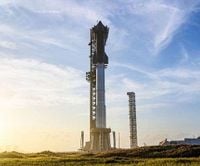SpaceX’s much-anticipated tenth test flight of its Starship rocket, the largest ever constructed, was abruptly postponed on Sunday evening, August 24, 2025, after technical issues with the ground systems forced the company to halt the countdown just minutes before liftoff. The towering 400-foot-tall rocket, which had been scheduled to launch from SpaceX’s Starbase facility near Boca Chica Beach, Texas, was fully loaded with propellants and poised for flight when the launch window was suddenly closed.
According to SpaceX’s official announcement on X (formerly Twitter), the company was “standing down from today’s tenth flight of Starship to allow time to troubleshoot an issue with ground systems.” The news left millions of space enthusiasts and watchers around the world in suspense, as the highly anticipated livestream was first delayed and then canceled altogether. No new date for the rescheduled launch was immediately provided, though SpaceX indicated that there were potential launch windows on Monday and Tuesday, pending resolution of the technical glitch.
Sunday’s postponement is just the latest in a string of setbacks for the Starship program in 2025. As reported by NPR and other outlets, the Starship rocket has experienced three consecutive failures this year alone, including a dramatic loss of control during a flight in May and an explosion during a routine engine test in June. In May, the rocket burned up as it plunged back into Earth’s atmosphere, while earlier tests saw fiery explosions over the Atlantic Ocean. Each of these incidents has added to the mounting pressure—and cost—on SpaceX’s ambitious program.
The Starship system itself is a feat of engineering, standing taller than the Statue of Liberty and designed to be fully and rapidly reusable. The rocket consists of two main components: the Super Heavy booster, approximately 70 meters (about 230 feet) long, and the upper stage, also called Starship, measuring about 50 meters (164 feet). The two stages are meant to separate after launch, with the booster performing a series of burns and hovering maneuvers over the Gulf of Mexico before splashing down, while the upper stage attempts to deploy simulated satellites on a suborbital flight.
SpaceX had high hopes for Sunday’s test, which was to last about an hour and put both stages of the rocket through their paces. The company’s technical brief, published last week, detailed the lessons learned from previous failures. The May mishap was attributed to abnormally high pressure in the nose cone, caused by a failure in the main fuel tank pressurization system diffuser. SpaceX engineers replicated the problem during ground tests and implemented a redesigned diffuser to reduce strain on the fuel tank structure. The June explosion, on the other hand, was traced to damage in a composite overwrapped pressure vessel (COPV)—a critical tank for storing high-pressure gases. To address this, SpaceX announced that future flights would operate COPVs at reduced pressure, with additional inspections and proof tests before loading reactive propellants.
Despite these setbacks, SpaceX’s founder and CEO, Elon Musk, has maintained a characteristically optimistic outlook. As quoted by NPR, Musk has said, “Success is uncertain, but entertainment is guaranteed!” Just hours before the planned launch, Musk posted on X, “Starship 10 launching tonight,” expressing confidence in the mission. After the scrub, he responded to a follower’s question about the flight’s objectives by emphasizing, “There are several goals, but most important is launching.” Later, he posted a sad emoji, reflecting his disappointment at the delay.
The stakes for Starship’s success extend far beyond SpaceX’s own ambitions. NASA is counting on the rocket to play a central role in its Artemis program, which aims to return astronauts to the Moon for the first time since 1972. SpaceX has been tapped to assist with the Artemis 3 mission, currently targeted for 2027, and Starship is slated to be the vehicle that lands astronauts on the lunar surface. Meanwhile, Musk’s long-term vision is even more audacious: to make humanity a multi-planetary species by enabling the colonization of Mars. He has floated plans for uncrewed Mars missions as early as 2028, using Starship as the workhorse for interplanetary travel.
Closer to home, Starship is also intended to support the deployment of SpaceX’s Starlink satellites, further expanding the company’s reach in global communications. The rocket’s fully reusable design is central to Musk’s vision of slashing the cost of space travel, making regular missions to the Moon, Mars, and beyond not just possible but sustainable. As reported by the New York Post, this cost efficiency is a key driver behind SpaceX’s relentless push to perfect the Starship system, despite repeated failures and public scrutiny.
Sunday’s postponement came as a particular disappointment to the legions of fans and industry watchers who had been eagerly awaiting the live broadcast of the launch. Confusion reigned in the minutes leading up to the scrub, as SpaceX provided no visuals or live commentary from Starbase, leaving many to speculate about the status of the mission. The announcement came via a simple text post on X, with no accompanying images or video. According to Tesla Oracle, both the upper stage Starship 37 and the first stage Super Heavy Booster 16 were in the midst of propellant loading when the technical issue was detected, prompting the last-minute decision to call off the launch.
Yet even as Starship’s woes continue, SpaceX’s other operations march on. Earlier on Sunday, the company successfully launched a Falcon 9 rocket carrying supplies to astronauts aboard the International Space Station—a reminder of SpaceX’s established prowess in commercial spaceflight. The contrast between the routine success of Falcon 9 and the ongoing challenges of Starship highlights the steep learning curve involved in developing a new, unprecedented launch system.
For now, the space community waits with bated breath for news of the rescheduled launch. With the Federal Aviation Administration having cleared the flight, and with new safety measures in place, hopes remain high that Starship’s next test will mark a turning point for the program. As SpaceX and NASA look to the future—toward the Moon, Mars, and beyond—the world will be watching to see if Starship can finally soar.
Space exploration is never easy, and the road to the stars is paved with setbacks as much as triumphs. But if history is any guide, perseverance and innovation often win the day. For Musk, SpaceX, and all who dream of reaching new worlds, the countdown continues.





